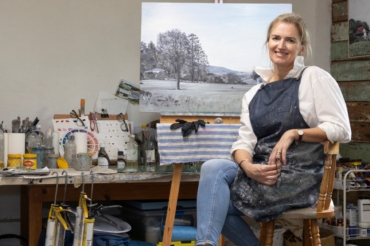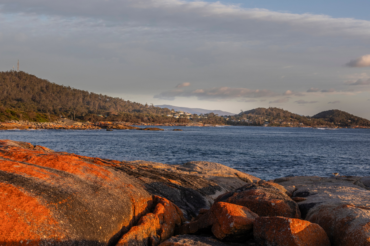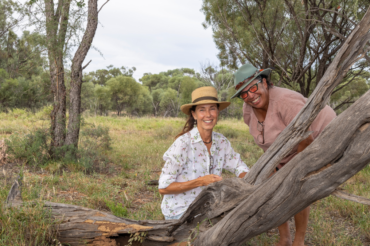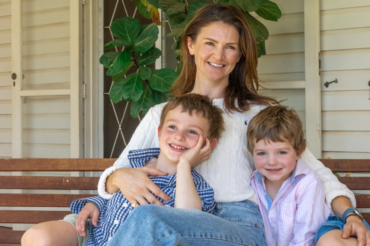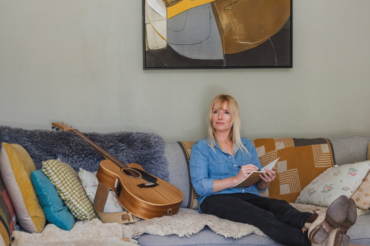
Like one of the characters in her rural romances, Maya Linnell is at a crossroad in her life.
Maya Linnell’s gaze is as clear as the view to the ocean from the studio where she writes from home at Narrawong on Victoria’s far south-western coast. “With the vision of hindsight, perhaps I should have invented 10 sisters in the McIntyre family,” she says. “But I only made four and now their stories are told.”
For the past five years, Maya has lived and breathed her fictional family’s every move, from her debut novel, Wildflower Ridge, to her latest offering on their lives, Paperbark Hill. The series, which also includes Bottlebrush Creek and Magpie’s Bend, is loosely set in Victoria’s Western Disrict, where Maya’s husband, Jason, grew up. Maya Linnell also grew up not that far away, just over the South Australian border at Tantanoola on the Limestone Coast. It’s where she did her journalism cadetship on the South Eastern Times and where she met Jason, an aircraft engineer. They eloped to Tasmania and came home to roost at Narrawong, where they built, quite literally, brick by hand-made brick, their cathedral-style home on eight acres (3.2 hectares) of farmland, which they share with a menagerie of animals and children Charles, 14, Amelia, 12, and Elizabeth, 10.

Along the way, Maya’s art imitates life, as her characters bake and garden their way through rural highs and lows, completing massive renovations, salvaging a country store and post office and starting a dahlia farm. But now, Maya is done with the McIntyre sisters and she’s deeply engrossed in a whole new set of characters who live in the Coonawarra wine district, a bit closer to her childhood home and the district where her parents still live.
“It’s both liberating and scary,” she says. “I was comfortable in that world I’ve inhabited for years. I knew their faces, personalities, support networks and the community they lived in. But now I have a whole new universe to populate with fresh characters. As with any newcomer to a region, I know there will be kind and caring, community-minded people and there will be grumpy oldies or young people who always seem to take the hard path.” But that’s just the start of Maya’s evolving story, as Jason, too, is embarking on a new career direction.

“‘It’s good for the children to see both of us following our dreams,’ she says. ‘Life’s too short for ‘what ifs’.’ Maya’s journey to achieving her lifetime’s ambition of becoming a novelist began about the time Elizabeth was starting school and Maya was looking to return to the workforce. “Jason asked me if I could do anything I wanted in the world, what would it be,” she recalls. “When I said, ‘Write a novel,’ he encouraged me to go for it. So I did and I was just so lucky that I found the Romance Writers of Australia (RWA). I couldn’t have found a more supportive bunch and they helped me structure my work and plan my writing in a more professional way.”
With a slightly more polished manuscript ready for pitching, Maya submitted it to Allen & Unwin as she was planning to head to Sydney for a RWA conference. She was beyond thrilled when the publisher signed her before she actually hit town.
These days, she aims to deliver a manuscript a year to her publisher and her schedule often means she is promoting one book while dealing with the extensive editing process for the next. She spends all the hours the children are at school writing and, now that they are becoming increasingly independent, and sometimes when they aren’t.

“There’s not much of my life that I don’t write about,” she says. “I suggested to Jason that I’d like to expand my dahlia garden into a farm and he reminded me that I already had two acres [0.8 hectares] of garden and a few other commitments. I thought, ‘Fine, I’ll let Diana [her most recent protagonist] develop a flower farm’.”
Working from home has never been an issue, and Maya is grateful for the support of a network of fellow writers called Not So Solitary Scribes. They number around 100 writers in total and gather according to whoever is available for online sessions on Fridays. “It’s a mix of aspiring and established authors,” Maya explains. “We catch up on Zoom and chat about everything from roadblocks we’ve hit to calling in expertise in areas we’re not familiar with. Then we turn the audio off and write for an hour, then reconvene for a final chat. It’s a lovely support network.”

In spite of the many accolades and awards she has received, Maya expresses frustration at the lack of recognition for so-called ‘commercial fiction’. “I know this is what most people read,” she says. “I take whatever opportunities come my way to meet my readers, whether it’s through regional writers’ festivals or book signings.”
Maya has also become the convenor of a national network of library lovers, hosting a free and interactive online event on the third Wednesday of each month. Her show – aptly named Library Lovers with Maya Linnell – is being rolled out to libraries across Australia, thanks to the Libby app, which provides library resources in digital form. “My role is to spread the word about this service, celebrating books, magazines and reading, and highlighting the different ways readers can stay connected,” she explains. “Every month, I interview a bestselling author, a librarian and someone from the magazine or audiobook world. Not only do I quiz them about their careers and what they’re reading, I get to find out what’s happening in their kitchens and gardens. The audience can ask questions too, and in October I’ll have the pleasure of featuring one of my writing idols, Jane Harper. It’s a wonderful way of connecting with a broader reading audience and the best part is, because it’s through libraries, everything can be read for free. I love having time with readers and writers and it really is a dream come true to spend my days working with words and advocating for good books.”
Maya’s books are liberally punctuated with references to baking. Here is a selection of her go-to recipes.
Scones

I’ve been making these scones for 15 years and they’re the most reliable recipe I’ve ever used (coming from a girl whose earliest attempt at drop scones were referred
to as rock scones).
Makes 12-13
3 cups self-raising flour,
plus extra for dusting
2 teaspoons icing sugar
2 teaspoons cornflour
1 egg
300ml full-fat thickened cream
Milk, for brushing
Heat oven to 220°C (200°C fan-forced). Sift dry ingredients or whisk together in a mixing bowl. Crack the egg into a measuring jug and then fill with milk to the half-cup mark. Mix with a fork. Add to the dry ingredients along with the cream. Stir together with a butter knife. Knead dough on floured bench top. Roll out until it’s about 3cm thick. Cut with a metal scone cutter (not a cup or water glass); brush tops with milk. Dust oven tray with flour, bake until perfect (they will smell cooked). My oven takes about 12 minutes and I turn the tray 180° once halfway through baking.
TIPS Make sure you cut all sides of the scone with the cutter. I never sift the dry ingredients, I use the whisk instead. You can add cheese and chives, or cheese and bacon for savoury versions.
Carrot cake
Enter the great carrot cake taste- testing competition. I think they’re both fabulous, but with five voters in our household, there was a 3:2 preference for the first recipe, which I modified from a taste.com recipe years ago. I switch between both recipes, but go ahead and make up your own mind (or do what I do and cook whichever recipe you have all
the ingredients for at the time).
Carrot cake with pineapple
2/3 cup vegie oil
2 eggs
1 teaspoon vanilla essence
124g (½ cup) crushed pineapple, drained*
80g (2/3 cup) chopped walnuts
or pecans, plus extra for decorating
1 1/3 cups grated carrot
(approximately 2 carrots)
1 1/3 cup sugar
1 1/3 cup plain flour
1 teaspoon ground cinnamon
1¼ teaspoons bicarbonate of soda
Preheat oven to 180°C (160°C fan-forced). Grease the sides and base of a 20cm round cake pan. Stir oil, eggs, vanilla, pineapple, nuts, carrot and sugar together in a large bowl. Sift in flour, cinnamon and bicarbonate of soda. Mix together. Bake for 1 hour 20 minutes (or until a skewer comes out clean). Cover cake with a clean tea towel and allow to cool in pan. When cake has cooled, spread top and sides with cream cheese icing (see following page) and sprinkle with extra nuts.
TIP I’ve substituted the pineapple for one mashed ripe banana and it works just fine too.
Carrot cake v2
1 cup plain flour
1 teaspoon bicarbonate of soda
1 teaspoon cinnamon
1 cup sultanas
1½ cups of grated carrots
(approximately 2 large carrots)
1 cup sugar
2 eggs
½ cup vegie oil
Preheat oven to 180°C (160°C fan-forced). Grease the sides and base of a 20cm round cake pan. Sift flour, bicarbonate of soda and cinnamon in a medium bowl. Set aside. Add sultanas, carrots and sugar. Mix well. Beat eggs and oil together with fork then add to the mix. Bake for 55-75 minutes or until a skewer comes out clean.

Cream-cheese icing
60g cream cheese, softened
30g butter, softened
2 teaspoons lemon juice
(fresh is best if you have it)
180g icing sugar sifted
Using an electric mixer, beat cream cheese, butter and lemon juice until light and fluffy. Gradually add sifted icing sugar and beat together until icing is smooth.
Blue ribbon yo-yo biscuits

This recipe was given to me by my neighbour Heather and has won both of us blue ribbons at the local baking show.
170g butter, softened
4 tablespoons of icing sugar
1½ cups plain flour
5 tablespoons custard powder
Preheat oven to 180°C (or 160°C fan-forced). Cream butter and icing sugar until light and fluffy. Add sifted flour and custard powder. Mix well. Roll teaspoons of mixture into small balls, place on greased or lined trays. Push down with a fork. Bake 10-15 minutes until golden. Cool well before icing. Match up similar sizes and sandwich together with stiff icing made from icing sugar, a teaspoon of melted butter and water.
TIPS: If mixture seems too dry after all ingredients are combined, or you’re overly generous in your dry ingredient measurements, just mix in a little melted butter until dough is moist enough to form a ball. For show events, I weigh the dough so the biscuits are uniformly 14g, and pipe the icing onto the biscuit. For home, I just dab the icing on with a spoon and nobody dares complain. Dip fork in water to stop it sticking to the dough. I like to change it up by adding a little passionfruit pulp or pink food colouring (and sometimes both) to the icing. Gives them a super-fancy look and taste. ac
Explore more Australian Country recipes here
Photography by Georgina Morrison

